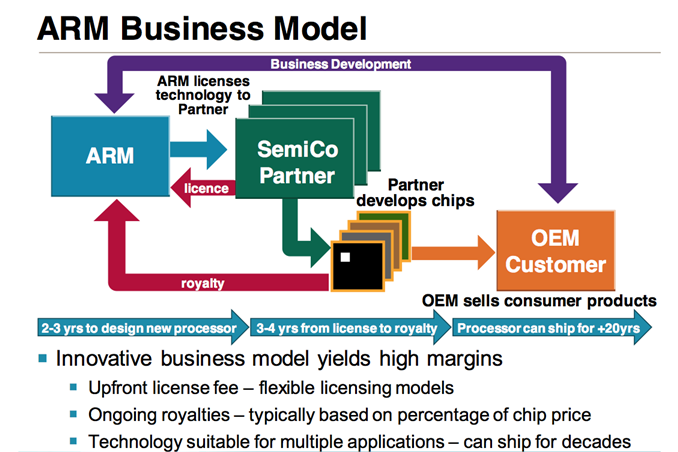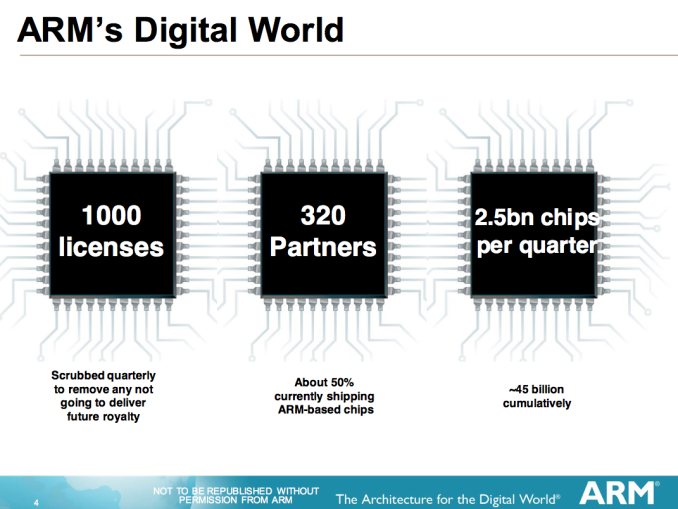The ARM Diaries, Part 1: How ARM’s Business Model Works
by Anand Lal Shimpi on June 28, 2013 12:06 AM EST
It must frustrate ARM just how much attention is given to Intel in the ultra mobile space, especially considering the chip giant’s effectively non-existent market share. Since 2008 Intel has tried, year after year, to break into smartphones and tablets with very limited success. Despite having the IP and technical know-how to do so, it wasn’t until 2012 that we saw Intel act like a company with even a sliver of a chance. Today, things are finally starting to change. Intel’s 22nm SoC process and updated Atom microarchitecture look very competitive, and we’ll see the first tablet products based on them later this year - with phones following sometime in early 2014. As Intel is about to start acting like a competitor, ARM is starting to talk a lot more about its magic.
We’ve had well over a decade of Intel sharing its beliefs with us, but this is ARM’s first attempt at doing the same. What will follow over the next few posts are a bunch of disclosures, some related some not, attempting to bring everyone up to speed on where ARM is today and where ARM will be in the near future. The best place to start is with ARM’s business model.
In the PC industry, the concept of a fabless semiconductor manufacturer isn’t unusual. NVIDIA has always been one, and now AMD is one as well. Fabless semiconductors create all of the designs for their chips, but they’re physically manufactured at a foundry partner (e.g. TSMC, Global Foundries, Samsung). The fabless semi approach greatly helps reduce costs, but your designs are ultimately at the mercy of your foundry partner. Capacity, quality of process and timeline for process are more or less out of your control. Sometimes this is a non-issue, but other times it dramatically impacts your ability to bring products to market (e.g. quality control for early TSMC 40nm, timeline for GF 28nm or early capacity for TSMC 28nm).
ARM goes one step beyond the fabless semi: it doesn’t even sell any chips into the marketplace. ARM instead, designs IP (instruction set architecture, microprocessor, graphics, interconnects) and licenses it to anyone who wants to use it. ARM’s customers will then take the IP they’ve licensed and design it into silicon. These customers can be fabless semiconductor companies or companies that own fabs.
It’s a very unique business model, especially if you compare it to that of the market share leader in the PC silicon space (Intel). From Intel’s perspective, it made the mistake of licensing the x86 ISA early on in its life, but quickly retreated from that business. It instead builds its own architectures, designs them into chips for various markets, and manufactures the designs at its own foundries. Intel is a truly vertically integrated chip design and fabrication house. It’s a lot of work, but Intel is rewarded by having extremely high margins on all of its products.
The ultra mobile world is very different, at least today. In the PC world, Intel drives platform definition and ends up being the biggest part of the BoM (Bill of Materials) as a result. In smartphones and tablets, the main applications processor is easily under 10% of the cost of the device. More often than not, we’re talking about low single digit percentages of the total BoM (e.g. $15 SoC for a $400 device, or 3.75%). Intel’s theory is that this will eventually change as silicon complexity increases inside ultra mobile devices, but until now (and likely for the near future) the market requires/enables a different sort of business model.
How ARM Works
The ARM business model is incredibly simple to understand, it’s just different than what we’re used to in the PC space. At a high level, ARM offers three different types of licenses: POP, processor and architecture.
A processor license is the license to use a microprocessor or GPU that ARM has designed. You can’t really change the design, but you get to implement it however you’d like. For example, Samsung’s Exynos 5 Octa implements four ARM Cortex A7 cores and four ARM Cortex A15 cores - these are processor licenses. ARM will provide guidelines as to how to implement these designs in silicon, but ultimately it’s up to you and your physical implementation teams to do so and get good frequency/power out of your design.
A processor optimization pack (POP), takes a processor license to the next level. If you aren’t great at physical implementations, ARM will sell you an optimized processor design that you can take and manufacture at a specific foundry which will result in some degree of guaranteed performance. If you look at what happened with the Cortex A8, Apple and Samsung had their own physical implementations of the core that resulted in better frequency/power than a lot of other designs. Apple and Samsung had access to Intrinsity who hardened the Cortex A8 design, but not all companies had the bandwidth/budget to do the same. POPs are ARM’s equivalent solution for those customers who need very good implementations but can’t do so by themselves. POPs are available for various processor/foundry/process node combinations. For example, ARM offers a 28nm HPM POP at TSMC for the Cortex A12.
The final option is an architecture license. Here, ARM would license you one of its architectures (e.g. ARMv7, ARMv8) and you’re free to take that architecture and implement it however you’d like. This is what Qualcomm does to build Krait, and what Apple did to build Swift. These microprocessors are ISA compatible with ARM’s Cortex A15 for example, but they are their own implementations of the ARM ISA. Here you basically get a book and a bunch of tests to verify compliance with the ARM ISA you’re implementing. ARM will offer some support to help you with your design, but it’s ultimately up to you to design, implement and validate your own microprocessor design.
In terms of numbers, ARM has around 1000 licenses in the market spread across 320 licensees/partners. Of those 320 licensees, only 15 of them have architecture licenses.












64 Comments
View All Comments
pluto7777 - Friday, June 28, 2013 - link
Exactly what is this IP they sell? Is it for hardware or software because Mali is a giant black box. Intel came to realize they could do more good for the end users by embracing open source. It's a shame this idea completely escapes ARM.ShieTar - Friday, June 28, 2013 - link
ARMs main IP is the processor design. Intel has absolutely no plans to make their Haswell-Designs open source. They also still sell their compiler and high performance libraries, so I really don't see how they are "embracing open source". Care to clarify your statement?Spunjji - Friday, June 28, 2013 - link
I'm fairly sure they're talking complete nonsense.name99 - Friday, June 28, 2013 - link
And it's not even Haswell's design. Intel produces a ton of software (like ICC and their math libs) which aren't open source...pluto7777 - Friday, June 28, 2013 - link
True, but it's evident Intel is at least trying. Even AMD has made some positive steps. Do yourselves a favor and look into Lima. ARM apparently doesn't like people reverse engineering their stuff.pluto7777 - Friday, June 28, 2013 - link
Intel has open source drivers on Linux. They actually employee people to work on this instead of other companies who only have closed source drivers and force other people to backwards engineer everything if they want an open driver.iwod - Friday, June 28, 2013 - link
Seeing both IMG ( MIPS ) and ARM are IP liscensing company, do both company's business mode work similary?And When will Anantech do a piece on the newly annoucned MIPS v5 "Warrior".
pluto7777 - Friday, June 28, 2013 - link
That's another true loss. I can't Imagine how anyone could want anything from Imagination Technologies. I hope they only get Microsoft support and don't try to leech off the open source community through some loophole like Android does.munsie - Friday, June 28, 2013 - link
I assume you mean the MIPS processor, not their GPUs? Because Apple has been shipping Imagination Tech GPUs since the first iPhone and Intel used them originally for their integrated graphics.ShieTar - Friday, June 28, 2013 - link
"In the PC industry, the concept of a fabless semiconductor isn’t unusual."And most chemistry labs also work with fabless semiconductors. I think this sentence is missing a word ;-)